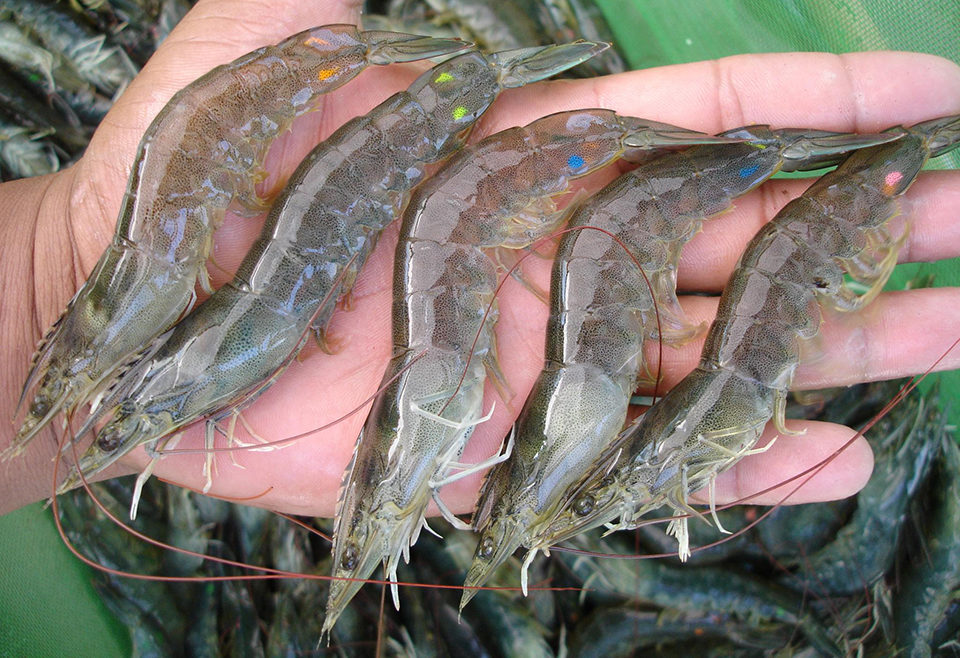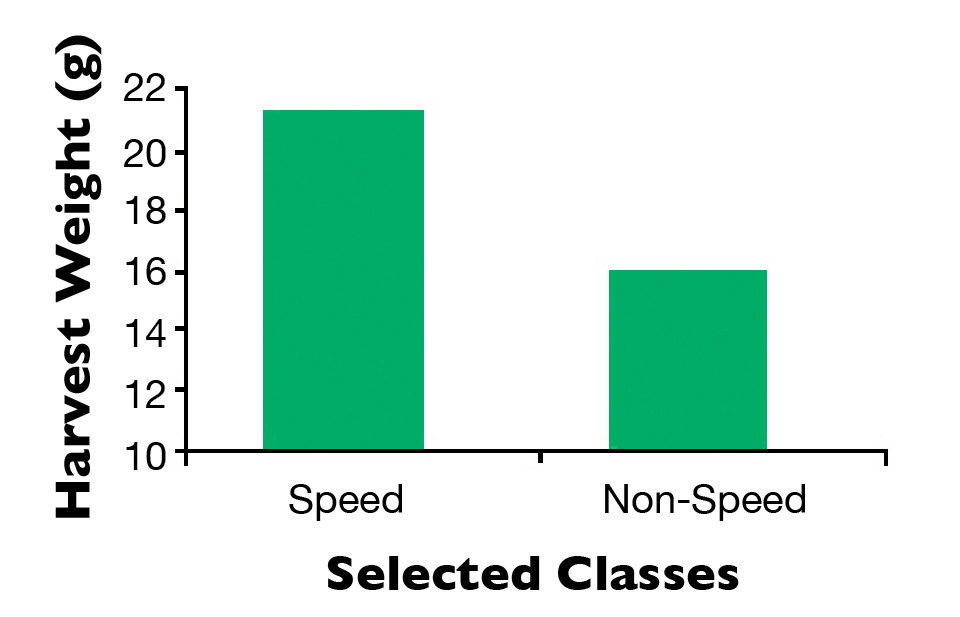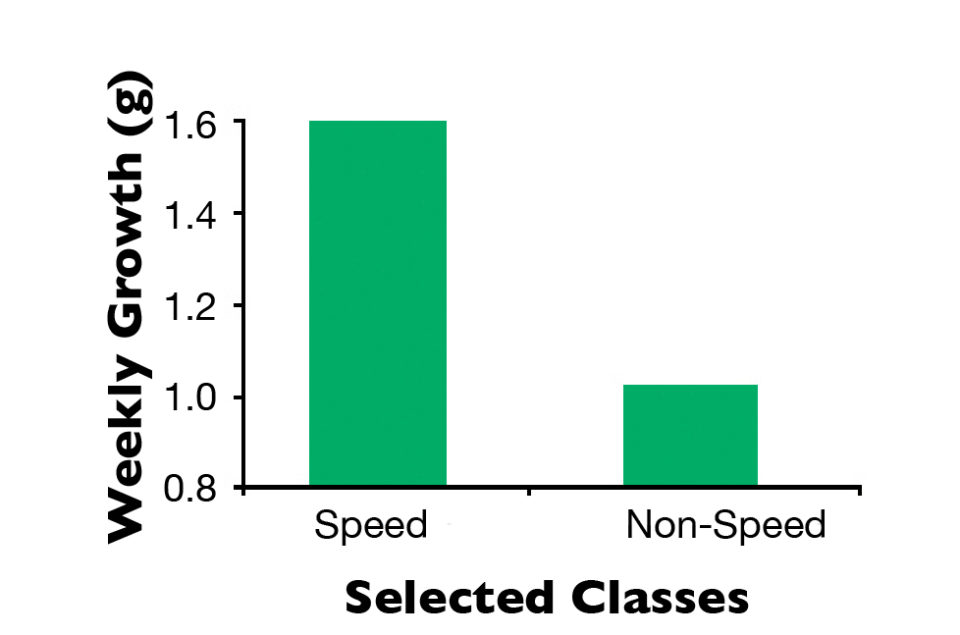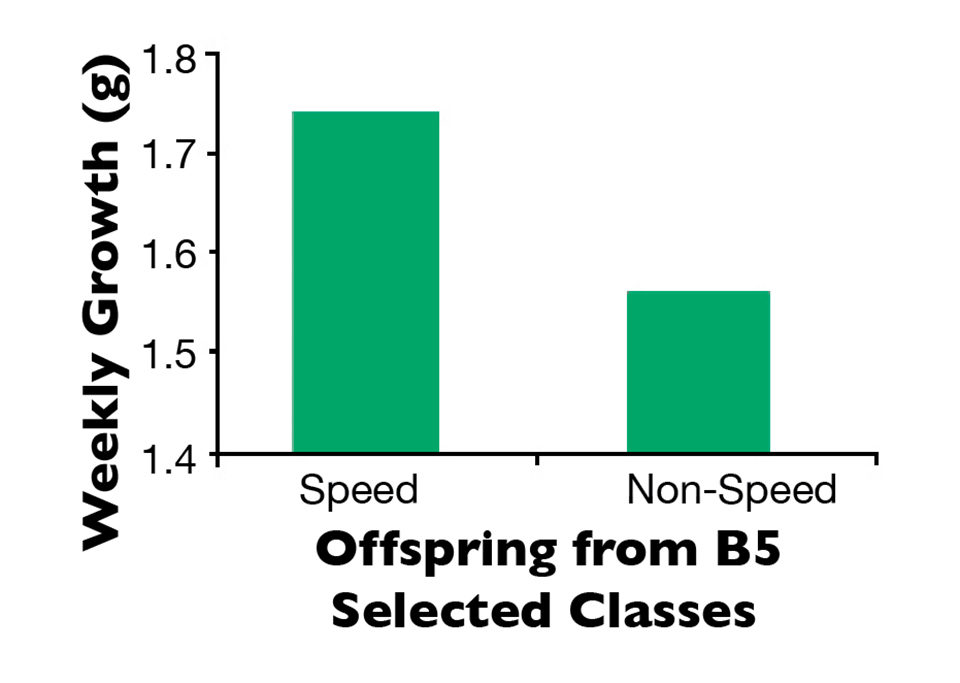
In 2007, the Brazilian shrimp-breeding company Genearch Aquacultura launched a specific pathogen-free genetic improvement program based on four annual batches of 60 families each and combining family selection for growth and survival, and within-family selection for growth.
For each batch, about 600 animals per family are stocked for genetic nucleus performance tests in which all 60 families are tagged with elastomers and grown together in nine tanks within a biofloc system. At harvest, only shrimp with the top 10 percent harvest weights are selected to become potential broodstock replacements.
The authors recently conducted a study to evaluate the within-family selection response being obtained for shrimp growth, the associated level of realized heritability for the trait, and any potential correlated effects taking place for grow-out survival and other traits.
Broodstock selection
At the harvest of the genetic nucleus performance tests for batch 5, besides the top 10 percent animals for harvest weight, those composing the 70 to 80 percentile of weight distribution were also selected to become potential broodstock replacements. Once the family selection step was exercised, and animals from the culled families were eliminated, the phenotypic difference in growth rates between the top 10 percent (designated the Speed group) and intermediate 70 to 80 percent (designated Non-Speed) was 0.57 g/week, which corresponded to a harvest weight difference of 5.4 g (P < 0.0001).
When the selected animals from batch 5 entered the maturation phase to produce batch 9, 13 batch 9 families were produced from crosses between Non-Speed batch 5 broodstock, and 40 batch 9 families were produced from crosses between Speed Batch 5 broodstock.
Among the 40 Speed families in batch 9, 26 had exactly the same parent family combinations as those for the 13 Non-Speed families. These 39 batch 9 families were elastomer-tagged and stocked together for performance testing.
They were subjected to the same environment, and their batch 5 parent families were the same. The only difference between them was the within-family selection intensity imposed on the batch 5 broodstock used to produce the two types of batch 9 families.
Phenotypic superiority
The selection results are summarized in Figures 1-4. When the batch 9 shrimp were harvested and their data analyzed, the contrasts between the Speed and Non-Speed families revealed a highly significant (P < 0.0001) phenotypic superiority for growth in the Speed families of 0.18 g/week and 1.2 g for harvest weight, but a slight 1.9 percent disadvantage for grow-out survival. No other correlated selection responses were observed for reproductive, larviculture or juvenile growth traits up to the elastomer-tagging stage.




The growth superiority brought about by the within-family selection exercised in batch 5 was, as expected, transmitted to the next generation, leading to a phenotypic superiority for growth of the Speed families in batch 9. For harvest weight, the 5.4-g phenotypic superiority in batch 5 converted to a 1.2-g “genetic” superiority in batch 9 with a realized heritability of 0.22.
More relevant is the realized heritability estimate obtained for weekly growth rate, 0.32. The 0.57 g/week phenotypic superiority in batch 5 converted to a “genetic” superiority of 0.18 g/week in batch 9. The slightly negative correlation for survival was more than compensated for by the positive selection response for growth, which would lead to a very satisfactory correlated response outcome of an additional biomass yield of 1.1 tons/ha with a stocking density of 122 shrimp/m2.
(Editor’s Note: This article was originally published in the September/October 2010 print edition of the Global Aquaculture Advocate.)
Now that you've finished reading the article ...
… we hope you’ll consider supporting our mission to document the evolution of the global aquaculture industry and share our vast network of contributors’ expansive knowledge every week.
By becoming a Global Seafood Alliance member, you’re ensuring that all of the pre-competitive work we do through member benefits, resources and events can continue. Individual membership costs just $50 a year. GSA individual and corporate members receive complimentary access to a series of GOAL virtual events beginning in April. Join now.
Not a GSA member? Join us.
Authors
-
João L. Rocha, Ph.D.
Genearch Aquacultura Lda.
Praia de Pititinga
R.N., CEP 59578 Brazil -
Ana C. Guerrelhas
Genearch Aquacultura Lda.
Praia de Pititinga
R.N., CEP 59578 Brazil -
Ana K. Teixeira
Genearch Aquacultura Lda.
Praia de Pititinga
R.N., CEP 59578 Brazil -
Flávio A. Farias
Genearch Aquacultura Lda.
Praia de Pititinga
R.N., CEP 59578 Brazil -
Ana P. Teixeira
Genearch Aquacultura Lda.
Praia de Pititinga
R.N., CEP 59578 Brazil
Tagged With
Related Posts

Health & Welfare
A case for better shrimp nutrition
Shrimp farm performance can often be below realistic production standards. Use proven nutrition, feeds and feeding techniques to improve profitability.

Health & Welfare
A holistic management approach to EMS
Early Mortality Syndrome has devastated farmed shrimp in Asia and Latin America. With better understanding of the pathogen and the development and improvement of novel strategies, shrimp farmers are now able to better manage the disease.

Responsibility
A look at integrated multi-trophic aquaculture
In integrated multi-trophic aquaculture, farmers combine the cultivation of fed species such as finfish or shrimp with extractive seaweeds, aquatic plants and shellfish and other invertebrates that recapture organic and inorganic particulate nutrients for their growth.

Aquafeeds
A look at phospholipids in aquafeeds
Phospholipids are the major constituents of cell membranes and are vital to the normal function of every cell and organ. The inclusion of phospholipids in aquafeeds ensures increased growth, better survival and stress resistance, and prevention of skeletal deformities of larval and juvenile stages of fish and shellfish species.


